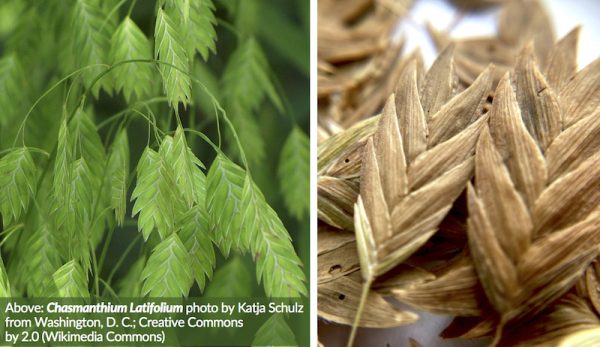
Cold weather has finally hit my garden, but I still managed to get one more set of seeds in the ground just the other day. River oats or Chasmanthium latifolium is an ornamental grass native to much of the U.S. and parts of Mexico. And, in order to germinate in spring, river oat seeds require a period of cold stratification.
Braving the cold to plant them in late fall is one of the simplest and most reliable ways to break this versatile plant’s dormancy.
You may know “river oats” by another name. Some people call Chasmanthium latifolium “sea oats,” “inland sea oats,” “northern sea oats,” “wild oats” or “wood oats.”
I’ve also seen river oats referred to as “spangle grass” or “spike grass.”
Plant Spotlight
I obtained my Chasmanthium latifolium seed from a Missouri-based man via the Seed Savers Exchange (SSE) network. Interestingly, regarding his river oat seed stock, the SSE member noted, “[This is a] different subspecies than sea oats, but [it] can cross with them.”
A clumping, ornamental grass, Chasmanthium latifolium grows rapidly during the spring. River oats’ distinctive seed heads come on in lovely shades of green over the summer. And, by late summer to early fall, they turn a golden brown.
(The last time I grew river oats, some of their seed heads even took on a bright crimson hue. Still, such showy color isn’t necessarily a given.)
In part, what you can expect depends on your available growing conditions. Chasmanthium latifolium can reach up to 5 feet tall. Although the grass has a mostly upright habit, it tends to bend under the weight of its showy seed heads (Incidentally, when thoroughly dried, these seed-bearing stems add visual interest to wreaths and flower arrangements.)
Read more: Seed Savers are leading the seed preservation movement.
Rain Gardens
River oat plants can tolerate full sun to partial shade as well as a variety of soil types. However, moist, well-draining growing conditions are ideal.
In fact, these plants are especially well-suited for inclusion in rain gardens. You can mix Chasmanthium latifolium with various sedges, swamp milkweed, queen of the prairie and other moisture-loving plants. These all work together to slow and filter stormwater runoff.
Erosion Control & Planting
If you have erosion-prone areas, you can plant groupings of river oats to help anchor the soil, too. Each individual plant can span about 2 feet across. That means, for thick beds of river oats, you should space plants just 1 to 2 feet apart.
Want a little more breathing room in your landscape? If so, put 3 to 4 feet between each plant instead. And keep in mind that Chasmanthium latifolium spreads via rhizomes as well as by seed. So, under the right circumstances, it can run amok. Fortunately, it’s pretty easy to keep in check—just use a sharp shovel to cut back rhizomes as needed.
Recently, I scattered river oat seeds in a few low-lying, swampy spots on my own property. To start, I turned over the soil, removing patches of grass and weeds as I went along. Next, I amended the area with some finished compost. Then I broke the seed heads apart into individual seeds and evenly distributed them across the planting bed.
Finally, I topped with a light covering of soil, watered well, and finished with a few inches of dried pine needles. (Using clean, dry straw to keep the seeds and soil in place is my usual go-to. It just happens that I had a plethora of pine needles and had run out of straw.)
Read more: The main challenge of living on a hill? Erosion.
Supporting Butterflies, Birds & More
River oats add value to the landscape in a few other ways. During the warmer months, river oats can support important pollinators.
For instance, you can intersperse this ornamental grass alongside nectar-bearing plants in the butterfly garden to feed many larval-stage skippers. (In particular, you may notice Bell’s roadside skippers (Amblyscirtes belli) and pepper and salt skippers (Amblyscirtes hegon), among others.) They may be smaller and less showy than charismatic species like monarchs and swallowtails, but skippers are no less important.
You might also spot some larval-stage common wood nymphs (Cercyonis pegala) and Northern pearly-eye (Enodia anthedon) butterflies as well.
And during the colder months? Leave your river oat seed heads standing and they’ll provide much-needed food and cover for birds and other critters.




